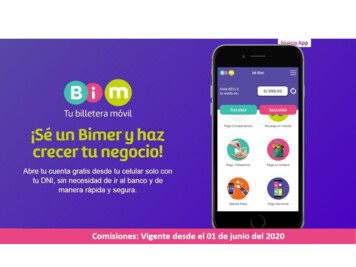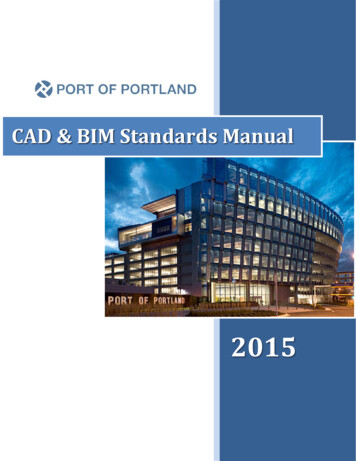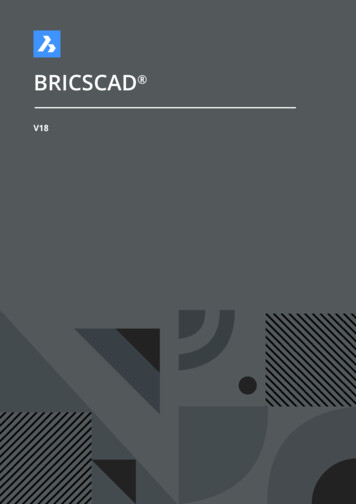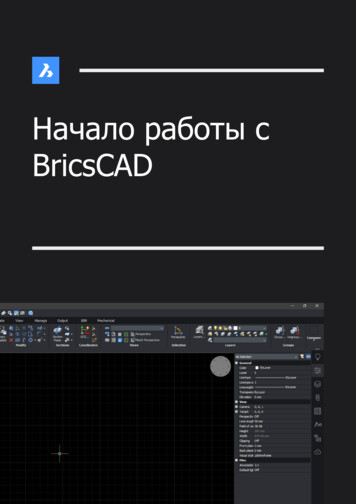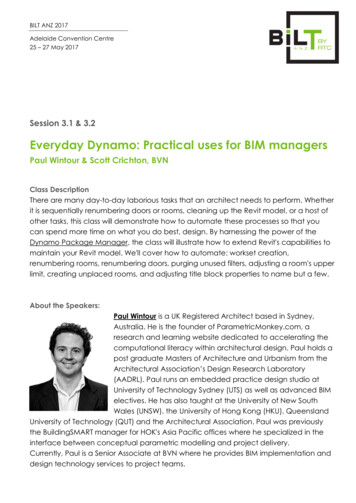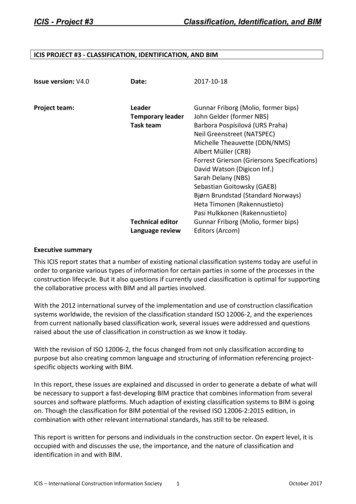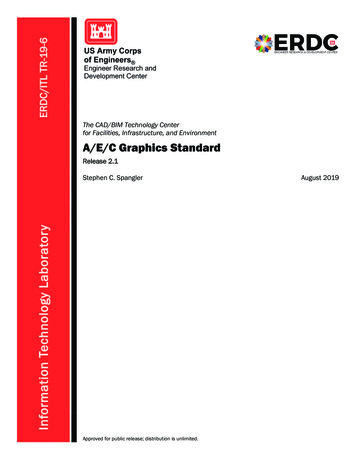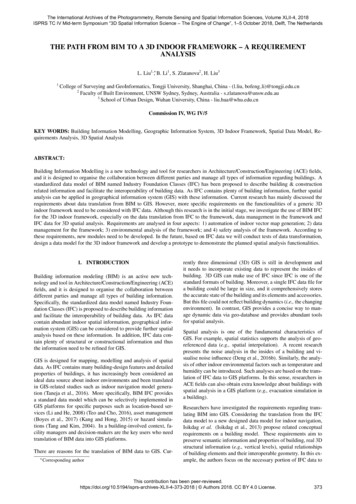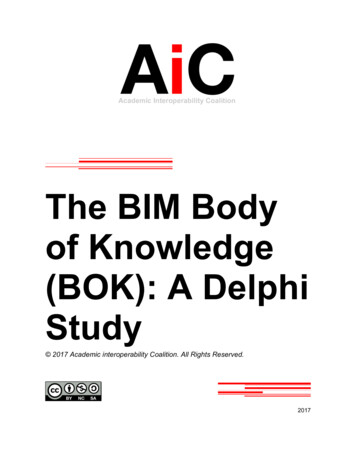
Transcription
Academic Interoperability CoalitionThe BIM Bodyof Knowledge(BOK): A DelphiStudy 2017 Academic interoperability Coalition. All Rights Reserved.2017
···················2017AiC BIM Body ofKnowledge Delphi Study 2017 Academic interoperability Coalition. All Rights Reserved. All rights reserved.A Report Submitted to the Academic interoperability CoalitionAuthors & AffiliationsWei WuGlenda MayoTamera McCuenR. Raymond IssaDeke SmithCalifornia State University- FresnoUniversity of North Carolina - CharlotteUniversity of OklahomaUniversity of FloridaDKS Information Consulting, LLCJune 12th, 20171 2017 Academic interoperability Coalition. All Rights Reserved.
···················2017TABLE OF CONTENTSExecutive Summary . 3Acronyms . 4List of Tables . 5List of Figures . 6Introduction – Call for the BIM BOK . 7Background . 9BIM Maturity and Performance Assessment . 9BIM Job Task Analysis . 9AiC BIM Job Task Analysis Mini Workshop . 10AiC BIM JTA Mini Workshop Outcomes . 10The AiC BIM BOK Delphi Study . 13The Delphi Method . 13AiC BIM BOK Delph Study: Panel Selection . 14AiC BIM BOK Delphi Study: Round 1 . 16AiC BIM BOK Delphi Study: Round 2 . 17AiC BIM BOK Delphi Study: Round 3 . 18AiC BIM BOK Delphi Study Results and Findings . 19Potential Use Cases of the AiC BIM BOK . 22The Use Case for Education . 23The Use Case for Talent Acquisition & Recruiting . 24The Use Case for Professional Certification/Credentialing . 25Concluding Remarks and Future Work . 25Appendix . 27Appendix A: 2015 AiC BIM JTA Mini Workshop Participants . 27Appendix B: AiC BIM BOK Executive Committee . 28Appendix C: AiC BIM BOK Delphi Study Panelists . 29References . 30Page 2 2017 Academic interoperability Coalition. All Rights Reserved.
E SUMMARYThe Academic Interoperability Coalition (AiC) has been a vehicle for communication and discussionconcerning how academics around the world, with a focus on the United States, have been introducing BIMto their students for over ten years. BIM education has been difficult to introduce because the continuouschallenge of providing students with the whole body of knowledge (BOK) they need to meet theexpectations of the workplace. Because of this difficulty and a lack of coordination, a plethora of approacheshave been explored. These range from training on how to use BIM tools to educating students in BIMconcepts and strategies.Educational institutions are tasked with graduating students who are prepared to be productive for the firmshiring them after successfully completing their studies. This has had varying levels of success at schoolsaround the country and the world. Academics have been coming together and sharing their positive andnegative experiences on teaching BIM through the AiC and its predecessors on an annual basis for morethan a decade. It was found that nearly every educator had a different approach that was focused ondifferent aspects of BIM education. A key aspect of BIM is that it is intended to be a collaborative tool forall practitioners, and it was found that on most campuses there was little or no collaboration among theacademic units teaching BIM.Since the accreditation boards have not yet identified criteria for credentialing BIM, it was felt that the AiCcould help mitigate the apparent divergence across programs. The AiC proposed that before BIM educationcould move forward, some common values should be established through a BOK that both curriculumdevelopers and corporate trainers could use as a focus and as a foundational step.The AiC initiated this grand effort of exploring the first-ever BIM BOK in early April 2015 with a BIM JobTask Analysis (JTA) mini workshop in Washington, DC. As the centerpiece of this research undertaking, athree-round Delphi Study for BIM BOK data collection and consensus building was conducted from midJuly, 2015 to end of July 2016. With unreserved support of the whole AiC membership and painstakingdedication of twenty-three (23) persevering Delphi Study panelists from design and construction practice,a total of sixty-seven (67)BIM BOK line items weredeveloped and consensuslevels were achieved bysubject matter experts(SMEs, i.e. the DelphiStudypanelists)withunprecedented granularitythat address four (4) levelsof implementation (LOI);four (4) roles of users(ROU); three (3) levels ofperformances (LOP); andtwo (2) types of knowledge(TOK), resulting in a total ofninety-six (96) differentscenarios. This reportserves as a summary of the first milestone of the AiC’s endeavor in BIM BOK research. It is noteworthy thatthis is accomplished with “Zero” funding and is all based upon voluntary work by the AiC members andDelphi Study panelists.3 2017 Academic interoperability Coalition. All Rights Reserved.
METOKVDCArchitecture, Engineering, Construction, Owner and OperatorAssociated General Contractors of AmericaAmerican Institute of ArchitectsAcademic Interoperability CoalitionAssociated Schools of ConstructionBetter Building Workforce GuidelinesBuilding Information ModelingBody of KnowledgeBIM Execution PlanCenter for Integrated Facility EngineeringConstruction Management Association of AmericaCommercial Workforce Credentialing CouncilDesign Build Institute of AmericaDepartment of EnergyIntellectual PropertyInterquartile RangeInternational Organization for StandardizationJob Task AnalysisKnowledge ManagementKey Performance IndicatorKnowledge, Skills and AbilitiesLevel of ImplementationLevel of PerformanceNon-Governmental OrganizationNational BIM StandardNational Institute of Building SciencesNational Renewable Energy LaboratoryReturn on InvestmentRole of UserStudent Learning OutcomeSubject Matter ExpertType of KnowledgeVirtual Design and ConstructionPage 4 2017 Academic interoperability Coalition. All Rights Reserved.
···················2017LIST OF TABLESTable 1. Align the Level of Performance with Bloom’s Taxonomy of Learning.Table 2. The 5-point Likert Scales and Levels of Measurement.Table 3. Combinatory Multi-criteria Evaluation for Levels of Agreement with Color Coding.Table 4. Keys for Heat Map Columns and the LOA Color Codes.5 2017 Academic interoperability Coalition. All Rights Reserved.
···················2017LIST OF FIGURESFigure 1. Preliminary BIM BOK Line Items by LOI Developed in the JTA Mini Workshop.Figure 2. The Dimensionality of the BIM BOK Classification and Categorization.Figure 3. Steps of Conducting the BIM BOK Delphi Study.Figure 4. Qualifications of the Selected Delphi Study Panelists: A) Job Titles Currently Held; B) Industry SectorsRepresented; C) Size of Company/Organization Represented; D) Highest Degree Attained; E) Years of Experience inDisciplines; and F) Project Life Cycle Phase Coverage.Figure 5. Geographical Distributions of the Delphi Panelists.Figure 6. A Snap Shot of Round 1 Delphi Study Questionnaire via Qualtrics.Figure 7. An Example of the Combinatory Multi-Criteria LOA Evaluation Process for Round 2 Results.Figure 8. An Excerpt of the Round 3 Consensus Evaluation Results.Figure 9. Round 3/Final LOA Distribution of BIM BOK per Classification/Categorization: a) LOA at LOI: Plan It; b)LOA at LOI: Coordinate It; c) LOA at LOI: Manage It; and d) LOA at LOI: Do It.Figure 10. The Tableau Public Visual Story for Data Visualization and Interaction.Figure 11. Backward BIM Curriculum Design with the AiC BIM BOK.Figure 12. An Example of Benchmarking BIM Job Position Qualification Using the AiC BIM BOK.Page 6 2017 Academic interoperability Coalition. All Rights Reserved.
TION – CALL FOR THE BIM BOKBuilding information modeling (BIM) has been gaining exponential growth and become a standard practicein global architecture, engineering, construction and owner/operator (AECOO) industry (McGraw-HillConstruction 2012). As with any new technology innovation, the industry began to examine the market forhow a technology is used and how to supply the required levels of expertise needed to facilitate its adoptionand diffusion (Gu and London 2010; Peansupap and Walker 2005; Rogers 1995). As several countries (e.g.the UK and China) have sanctioned BIM mandates, the adoption and implementation of BIM is approachinga critical mass. The market demand for BIM talent is thus growing steadily and rapidly. The projectedsupply/demand equation for BIM-savvy employees will place acute pressure on companies to acquire BIMtalent externally or cultivate in-house BIM competency to increase knowledge worker productivity and staycompetitive in business (Smith and Tardif 2009).Traditionally, education, training, and certification have been playing significant roles in preparing andfostering industry in innovation-driven market transformation (McGraw-Hill Construction 2012; Wu and Issa2014). Nevertheless, the pervasiveness of BIM adoption and implementation is unprecedented, andaccordingly, there is significant variance in knowledge aggregation, skill sets development andstandardization of best practices across industry sectors under disparate technological, socio-economicand cultural contexts. In other words, there is a lack of systematic understanding and absence ofestablished core knowledge, skills and abilities for successful BIM deployment. Specifically, the gaps thatcurrently exist for articulating BIM knowledge include the lack of validated articulation of BIM jobdescriptions and qualifications for BIM-oriented job positions (Wu and Issa 2014). There is also a lack ofbreadth and depth in knowledge structure, performance standards and assessment metrics regarding thequalifications to address the progression of intellectual needs at the task, project, and organizational levels.Job task descriptions and performance levels will aid an employer with the capability of advertising forpositions and additionally in assessing potential candidates for talent acquisition. Essentially, what thecommunity of BIM practitioners, educators and service users need is a body of knowledge (BOK), whichcan be defined as the complete set of concepts, terms, values, principles, activities and outcomes thatmake up a professional domain (Ören 2005; Wideman 1995). Thus, the proposed BIM BOK can beleveraged to aggregate, manage, disseminate and advance fundamental understanding and best practices,facilitate continuous discovery, encourage self-reflective growth, and foster validation and standardizationpertaining to BIM and its implementation in a holistic and systematic manner.The exploratory BIM BOK project was directed as the first of its kind to investigate expectations andperceptions towards the multidimensionality in documenting and benchmarking professional BIM practicesand performance outcomes. This project was directed under the leadership of the Academic InteroperabilityCoalition (AiC), which has been a vehicle for communication and discussion concerning how academicsaround the world have been introducing BIM to their students for over ten years (McCuen 2014). Theoverarching goals of the BIM BOK project include:A) To establish contemporary and comprehensive metrics of BIM competency assessment forworkforce across the AECOO industry under a broad variety of contexts. Existing literature andmetrics developed so far lack the dimensionality to address the integrative performance ofindividuals, projects and organizations in BIM implementation under one unified and holisticframework;B) To create a common curriculum and roadmap to bridge the gap between college educationoutcomes and workplace performance requirements; to advance understanding of BIM’s businessvalue and foster further development of BIM use cases, and to prioritize BIM education andintellectual preparation in sustaining the BIM market transformation; andC) To standardize the level of expectation and benchmark job task performance for emerging BIM jobtitles (e.g. BIM/VDC Engineer, BIM/VDC Manager, BIM/VDC Coordinator, and BIM/VDC Director),and create the baseline performance measurement for BIM education accreditation, professionalcredentialing and certification.7 2017 Academic interoperability Coalition. All Rights Reserved.
···················2017Page 8 2017 Academic interoperability Coalition. All Rights Reserved.
NDBIM Maturity and Performance AssessmentBIM maturity and performance assessment are necessary to evaluate the effectiveness of strategies andactual performance of BIM adoption and implementation by individuals, projects, and organizations. BIMmaturity refers to “the quality, repeatability and degrees of excellence within a BIM capability/competency”Succar (2010). Maturity assessment typically applies to the whole spectrum of competency levels ofindividuals, projects and organizations, while performance assessment is usually used in organizationaland project settings. BIM maturity and performance assessment can help stakeholders prioritize themanagement of impact factors towards specific business goals in BIM adoption and implementation. Oneof the earliest efforts on BIM maturity assessment framework was documented in the National BIMStandards (NBIMS), Part 1-Version 1 and demonstrated through the NBIMS Capability Maturity Model(CMM) and its application version, the Interactive Capability Maturity Model (I-CMM) (McCuen et al. 2012;NIBS 2007). Succar (2010) established a comprehensive BIM Maturity Matrix (BIm³) based upon the BIMExcellence framework created in Succar (2009). BIm³ was built as a knowledge tool with an expandabledatabase that incorporates five major metrics: BIM capability stages (Pre-BIM, Modeling, Collaboration andIntegration), BIM maturity levels (Initial/Ad-hoc, Defined, Managed, Integrated and Optimized), BIMcompetency sets (Technology, Process and Policy), Organizational Scales (Macro: markets and industries;Meso: projects and teams; and Micro: organizations, units and teams/members) and Granularity levels (e.g.Technology, Software, Data). BIm3 was expected to be applied across the construction industry at differentscales but its current uses were focusing on individual competency assessment within organizations(Succar et al. 2012; Succar et al. 2013). Likewise, Stanford’s Center for Integrated Facility Engineering(CIFE) initiated the VDC Scorecard program in 2009 to evaluate and benchmark the maturity of VDC/BIMpractices, and later was commercialized through the bimSCORE program (Kam et al. 2013). Another similareffort was the BIM Quickscan, developed by the Netherlands Organization for Applied Scientific Research(TNO) in 2009, which was a benchmarking instrument used to assess the BIM performance of companiesexecuting BIM services based upon questionnaire-like scores of weighted key performance indicators(KPIs) (Sebastian and van Berlo 2010). Most recently, Giel and Issa (2016) proposed and developed aframework for evaluating BIM competencies exclusively for facility owners with specifically tailoredcompetency categories using the Delphi technique. Only a few cases (Pikas et al. 2013; Succar and Sher2014) introduced the conceptual workflow to identify, classify, and aggregate BIM competency items thatneed to be taught at educational institutions or trained on the workplace to equip current and future industryprofessionals with the necessary knowledge and skills to engage in collaborative workflows and integratedproject delivery.BIM Job Task AnalysisAt a time when BIM job titles are just emerging, and when desirable knowledge, skills, and abilities (KSAs)pertaining to BIM are yet to be defined, a Job Task Analysis (JTA) is an appropriate and valuableundertaking to provide insights into the intellectual gaps in organizations and strategize for talent acquisitionto catalyze BIM competency development and maturity growth. The JTA also encompasses education andtraining, which is the desired pinpoint for extending industry workforce development to college education.By definition, a JTA is “a formal, industry-accepted study, validated by a group of subject matter experts(SMEs), that defines competencies in terms of knowledge, skills, and attitudes (KSAs) as the basis foreducation/training curricula” (Wolfe et al. 1991). To perform the JTA, a small group of SMEs are assembledas a representative sample within the profession/occupation under study. The group may either be strictlyincumbents in the job under study, supervisors and managers who directly interact with the job underconsideration or a combination of both. The procedure to conduct a JTA according to (Studer and Kemkar2012) can be summarized in the following seven (7) steps:1. Identify a JTA development method.2. Retain a group of subject matter experts.9 2017 Academic interoperability Coalition. All Rights Reserved.
7.Hold the development workshops.Create JTA drafts.Facilitate a public comment period.Survey validation.Incorporate comments and publish final JTAs.AiC BIM Job Task Analysis Mini WorkshopThe AiC BIM BOK endeavor was initiated at the 9th BIM Academic Symposium via a BIM Job Task Analysis(JTA) mini workshop in Washington DC on April 8th, 2015. The BIM Academic Symposium is the officialannual meeting of the AiC and is regarded as a think tank meeting that convenes knowledge and wisdomof BIM education and best practices in both educational and professional communities. The AiC BIM JTAprovided the ideal vehicle to deliver the foundational work for establishing the BOK. It offered a holisticapproach to define and develop strategies for conducting BIM competency assessment and creatingeducation and training curriculum as well as certification and credentialing programs. The long-termobjectives of the AiC BIM JTA included: Identify industry trends in workforce development driven by BIM implementation;Create a comprehensive competency model that comprises of foundational BIM KSAs with SMEsinputs and rigorous validation;Develop a matrix of learning objectives for BIM training and education curricula with integration ofeffective assessment measures; andDevelop BIM competency and cultivate a BIM culture across organizations and academicprograms.Ideally, the AiC could have taken the JTA approach to its full extent to explore and develop the BIM BOK,should there be sufficient funding, time commitment and other resources that had been identified as criticalto the success of comparable JTA projects conducted by National Renewable Energy Laboratory (NREL)for energy auditors (Kurnik and Woodley 2011) and National Institute of Building Science (NIBS) for buildingcommissioning professional (Woodley and DePascale 2015) and building operations professional (Woodley2015). Therefore, as a voluntary-based research project with zero financial budget, more affordablesolutions such as a web-based Delphi Study instead of the co-located multi-day workshop seemed to bemore viable.AiC BIM JTA Mini Workshop OutcomesThe AiC BIM JTA mini workshop was designed and conducted as a brainstorming session. The audiencerepresented a well-balanced participation from both academia and industry with domestic and internationalfootprints (see Appendix A). This collaborative brainstorming session included extensive discussions onBIM use cases across industry sectors under varied organizational and project contexts. Distinctcompetency requirements and desired personnel qualifications associated with job tasks at various phasesof the whole project life cycle were identified with reference to existing guidelines and standards includingthe OmniClass Table 31 (OmniClass 2006) and the ISO 15686-10: 2010 (ISO 2010) standard. To identifya starting list of BIM uses, the workshop participants reviewed the BIM Project Execution Planning Guide,Version 2 (CICRP 2010). Meanwhile, buildingSMART International also established a list of forty BIM usecases which are categorized based on processes such as design, procure, assemble and operate (NIBS2015). It is worth mentioning that the workshop did not attempt to benchmark BIM competency for specificjob titles/positions in a particular industry sector. Instead, the goal was set to build a foundational researchframework to explore the BIM body of knowledge (BOK) with broad involvement of stakeholders in theAECOO industry. At the conclusion of the workshop, the AiC BIM BOK Executive Committee (hereinafter“the Committee”, see Appendix B) was formed and charged with responsibilities to carry out next-stepresearch endeavors in further developing the BIM BOK.There were two major deliverables of the AiC BIM JTA mini workshop. First, a preliminary list of sixty-seven(67) potential BIM BOK line items was proposed by the participants and was subject to further verificationand development (Figure 1). Second, a system architecture was created to classify and categorize thePage 10 2017 Academic interoperability Coalition. All Rights Reserved.
···················2017Model qualitycontrolManage BXPRefine BXPPerformancemeasurementModel validationStandardscompliancecheckingBuy-in fromstakeholdersthroughout theorganizationContract languageManage workforceProject controls budgeting /costProject controls scheduling /timeProject lifecycledata collection feedback loopLeadership - constructionissue resolutionEvaluate metricsProtecting IP ofdigital assetsProfessional ethicsDo It (13)Technical supportfor interoperabilityModel coordinationPre-constructionissue resolutionSoftware versioncoordinationProviding traininigUnderstand theroles of all phasesof the life cycleManage It (21)Organizationalmission statementBXP: ProcessmappingBXP: InformationexchangeBXP: GoalsBXP: BIM usageBXP: ProcurementstrategyISO 15686-10: Lifecycle functionalperformanceInfrastructureplanningQuality assuranceeffortBusiness markingpracticesSecurity policyRisk ctureLife cycleassessmentCorporate/organizational learningOrganizationaltraining of othersProfessionaldevelopmentInternal standardsacross theorganizationDevelop taffing projectsBudget (VDC/BIM)Software selection& upgrade strategyCoordinate It (6)Plan It (27)proposed and future BIM BOK line items (Figure 2). The classification and categorization criteria employedin this system architecture were based upon a discussion on macro and micro levels of BIM uses, anddiscretion drawn from project management literature:Rendering formarketingIndividual effortUnderstands justyour own modelAbility to build amodelAggregate a modelSoftware usageSolving problemsand gainingknowledgeEstimatingSite logisticsList of BIM usesKnowledge ofscriptingKnowledge ofprogramingTechnical writing11 2017 Academic interoperability Coalition. All Rights Reserved.
···················2017Figure 3. Preliminary BIM BOK Line Items by LOI Developed in the JTA Mini Workshop.Figure 4. The Dimensionality of the BIM BOK Classification and Categorization. Levels of Implementation (LOI): LOI address the business decision-making hierarchy on BIMuptake and utilization, descending from Plan It and Coordinate It (macro level, inter- and intraorganizational level) to Manage It and Do It (micro level, project and task level). Roles of Users (ROU): ROU acknowledge the commonality and disparity of BIM uses across theAECOO industry sectors in reference to the OmniClass Table 33 – Disciplines (OmniClass 2006),and regroup BIM users into four representative categories including Designers (architecture andengineering), Contractors (general and specialty), Facility Managers/Operators, as well asConsultant/Generalist. Levels of Performance (LOP): LOP indicates the stratification of performance depending oneducational background and professional experience, and suggest the progression of performancefrom Entry, Middle to Full via college education and professional training. To facilitate thedevelopment of BIM curriculum, LOP also aligns BIM learning/training outcomes with Bloom’sTaxonomy of Learning (Krathwohl 2002) (see Table 1). Types of Knowledge (TOK): TOK inherits the concepts of Knowledge Management (KM) in theAECOO industry, and highlight its project-based nature. As a matter of fact, projects are alsoidentified as temporary organizations (Howard 1991; Turner and Müller 2003). Therefore,organizational general knowledge and project specific knowledge are both critical constituents ofthe BIM BOK.Table 1. Align the Level of Performance with Bloom’s Taxonomy of Learning.Level of PerformancePerformance ExpectationBloom TaxonomyEntry LevelPerformance expected for users with a Bachelor's degree orequivalent technical educationRememberingMiddle LevelPerformance expected for users that meet Entry Level qualifications Applyingplus 3-5 years of experience in BIM practicesAnalyzingFull PerformancePerformance expected for users that meet Middle Levelqualifications plus 5 or greater years of experience in BIM practicesPage 12 2017 Academic interoperability Coalition. All Rights Reserved.UnderstandingEvaluatingCreating
···················2017To put it into perspective, a research framework can be established upon this BIM BOK system architectureto allow and facilitate inclusive investigation on BIM competency with the broadest stakeholder involvementby addressing the depth and breadth of BIM uses among professional and educational communities froma total of 4 (LOI) x 4 (ROU) x 3 (LOP) x 2 (TOK) 96 scenarios.The AiC BIM JTA Mini Workshop laid the foundation for the subsequent Delphi Study that was directed toreview, expand and verify the preliminary list of BIM BOK line items. The Committee strived for a consensusbuilt upon perceptions of the subject matter experts (SMEs) to finalize and produce the first-ever BIM BOKof the AECOO industry.THE AiC BIM BOK DELPHI STUDYImmediately after the JTA mini workshop, the Committee convened a series of web conferences to plan forthe next step BIM BOK project activity. The Committee concurred that it was imperative to solicit directinputs from subject matter experts (SMEs) and have them critique, expand and establish consensus on thepreliminary BIM BOK deliverables. The Committee also agreed upon the best approach to conducting thisstudy by using the Delphi method.The Delphi MethodThe Delphi technique, mainly developed by (Dalkey and Helmer 1963) at the Rand Corporation in the1950s, is a widely used and accepted method for achieving convergence of opinion concerning real-worldknowledge solicited from experts within certain topic areas. This technique is considerably desirable toreach consensus on a field where a lack of agreement or incomplete knowledge is evident (Giannarou andZervas 2014). It is optimum for analysis of the opinions and perceptions, and provides a means to developa direction for an industry’s existing practices and/or review of future direction (Hsu and Sandford 2007).Considering the fi
AECOO Architecture, Engineering, Construction, Owner and Operator . educators and service users need is a body of knowledge (BOK), which can be defined as the complete set of concepts, terms, values, principles, activities and outcomes that . management of impact factors towards specific busine
